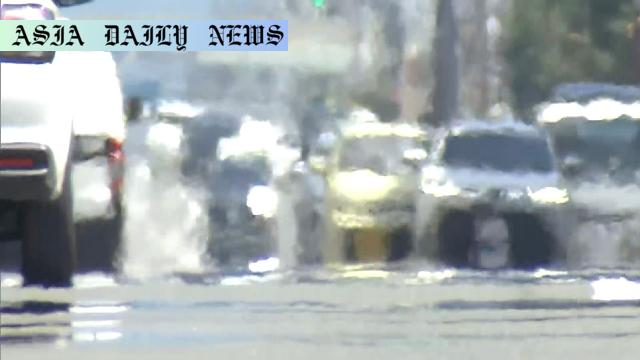Heatwave grips Japan: Temperatures soar beyond 39°C, life-threatening warnings issued.
- Scorching heatwave hits Japan, with temperatures exceeding 39°C in several regions.
- Meteorological Agency warns about life-threatening heat in multiple cities like Kitami and Fukuchiyama.
- Heatstroke alerts issued for wide areas; residents advised to stay hydrated and avoid prolonged outdoor activities.
- Unstable atmospheric conditions occasionally resulting in heavy rains and thunderstorms in eastern Japan.

Scorching Heatwave Grips Japan: A Life-Threatening Threat
Japan is currently facing a historic and life-threatening heatwave, with temperatures soaring above 39 degrees Celsius in several cities. From central cities such as Fukuchiyama in Kyoto Prefecture, to northern regions like Hokkaido, the rising mercury has set alarming records. On Tuesday, temperatures reached as high as 39°C in Fukuchiyama and nearly 38.6°C in Date City, Fukushima Prefecture. The Japan Meteorological Agency has highlighted that a high-pressure system is responsible for this unprecedented temperature surge, gripping the archipelago from northern to western parts of the nation. For citizens in critical areas such as Kitami, Hokkaido, Tuesday’s temperature highs neared the fatal 40°C mark. The heat poses immediate risks demanding vigilance and precautionary actions.
Widespread Heatstroke Alerts: Staying Safe Amid the Crisis
In response to the extreme conditions, heatstroke alerts have been issued over vast areas from Hokkaido in the north to Kyushu in the southwest. The alerts underscore the importance of taking preventive measures to minimize heat-related health risks. Simple tips like staying indoors during midday, using air conditioning, hydrating with ample amounts of water and electrolytes, and avoiding lengthy exposure to outdoor activities could save lives. The situation is described as life-threatening, and officials are urging immediate action to mitigate risks, especially for vulnerable populations such as the elderly, children, and outdoor workers. Past events have shown that swift and organized response strategies can make the difference between life and death in such extreme conditions.
Unstable Atmospheric Conditions: From Scorching Heat to Heavy Rain
Adding to the relentless heat, unpredictable changes in atmospheric conditions have been noted in eastern Japan. The continued heat, juxtaposed with cold air masses, has caused instability across inland regions. These conditions are predicted to trigger heavy rainfall, mudslides, and lightning storms throughout Tuesday night and Wednesday. Weather alerts caution residents to prepare for sudden environmental changes, including flooding risks and gusty winds. Local authorities are stepping up efforts to ensure the safety of communities, advocating for adherence to disaster preparedness protocols and awareness of developing weather conditions to navigate this dual threat effectively.
Economic and Social Impacts
The consequences of this heatwave extend far beyond just the immediate health risks. Local businesses and outdoor industries, such as agriculture and construction, are bearing the brunt of these extreme conditions. Farmers across the nation have reported concerns over failing crops due to the prolonged stretch of high temperatures, potentially exacerbating inflation in food prices. Employers in outdoor sectors are reassessing their workforce operations, prioritizing the health and safety of their employees above productivity. Meanwhile, the government is actively coordinating relief measures and has set up emergency service hotlines to address escalating concerns from the public. As Japan braces itself for the worst effects of climate anomalies, these occurrences serve as stark reminders of the immediate need to combat climate change and bolster resilience measures for similar challenges in the future.
Preparing for the Future: Lessons in Resilience
With the increasing frequency of record-breaking weather events, there’s a pressing need to reassess both personal and national preparedness. Technological solutions such as smart weather prediction systems and renewable cooling mechanisms could be introduced across communities. Instead of viewing these heatwaves as isolated phenomena, policymakers must embrace long-term climate mitigation strategies to protect citizens and maintain sustainable living conditions. Additionally, fostering local awareness campaigns will play a crucial role in shaping societal readiness for future disasters. The current crisis presents an opportunity for Japan and the rest of the world to take decisive action in embracing sustainable practices and investing in climate resilience efforts, for a safer, collective future.



Commentary
Climate Change and Its Role in Japan’s Heatwave
As temperatures in Japan breach life-threatening levels, the role of climate change in escalating weather extremes can no longer be ignored. Events like these serve as a wake-up call for both citizens and policymakers to confront the challenges posed by global warming. The high-pressure system triggering this heatwave is likely exacerbated by overall changes in atmospheric patterns linked to rising global temperatures. Such weather patterns demand urgent action on sustainability and climate policy.
The Human and Environmental Cost
Heatwaves aren’t just numbers on thermometers—they translate into tangible costs for individuals and communities. Vulnerable populations, such as the elderly and those with pre-existing health conditions, are directly susceptible to heatstroke and other heat-induced ailments. Environmental systems also bear the brunt of such prolonged heat, with local ecosystems suffering from dried-up rivers, wilting vegetation, and heat-stressed wildlife. It is clear that we are operating within an urgent timeline to safeguard these critical systems.
A Call for Long-Term Resilience
The increasing intensity of these heatwaves demands systemic change. Governments must invest in heat-resilient infrastructure, urban planning, and better public education campaigns surrounding climate adaptation. On an individual level, understanding how to stay safe, from identifying heatstroke symptoms to preparing for emergency weather, will be quintessential survival knowledge in the upcoming decades. As we face these immediate challenges, we also need to build a sustainable vision for the future, where global cooperation on climate solutions becomes a necessity rather than a choice. Together, these measures can help humanity weather the storm and lower the risks of future global catastrophes like the one unfolding in Japan.